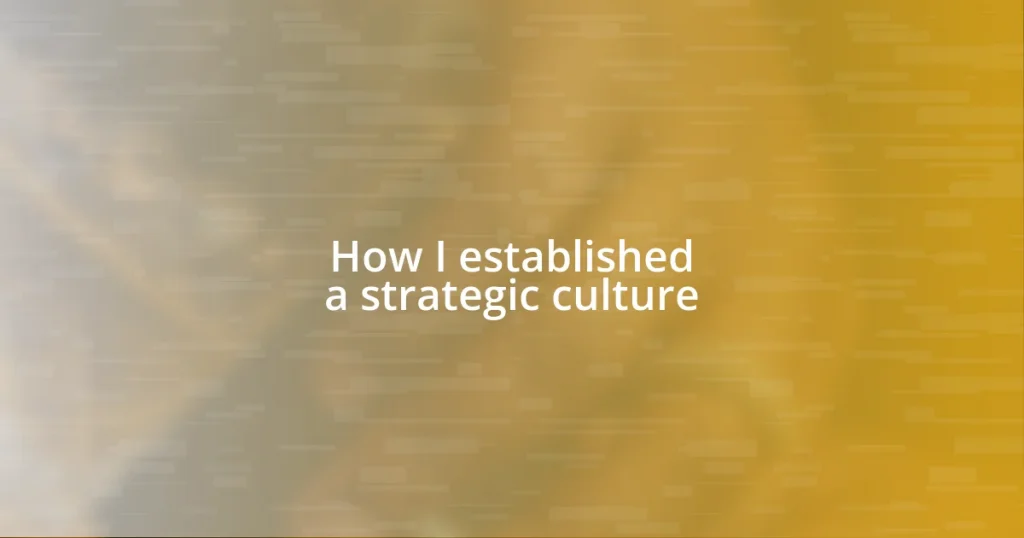Key takeaways:
- Understanding strategic culture is essential for organizations, influencing decision-making and shaping identity through shared values and experiences.
- Effective leadership is crucial in fostering a positive organizational culture, as leaders model behaviors and reinforce core values that energize teams.
- Measuring cultural impact involves using employee feedback, observing team dynamics, and sharing personal stories, highlighting both tangible and intangible shifts in the organization.

Understanding strategic culture
Understanding strategic culture is vital for any organization looking to thrive in today’s complex environment. It shapes how an organization perceives threats, opportunities, and its overall approach to achieving goals. I remember when I first encountered this concept; it struck me how deeply ingrained cultural values can influence decision-making processes. Have you ever thought about how your own experiences shape your strategic choices?
Strategic culture isn’t just an abstract idea—it’s a lived experience that impacts daily operations. I once worked with a team that valued collaboration above all else. This belief created a culture where innovative ideas could flourish, but it also made us hesitant in situations that demanded swift, decisive action. How would you balance such a dynamic within your own organization?
At its core, understanding strategic culture involves recognizing the interplay of history, values, and experiences that shape an organization’s identity. It’s fascinating to reflect on how past decisions, both good and bad, echo into the present. Can you think of instances in your journey where these elements significantly affected outcomes? These reflections can open doors to stronger, more coherent strategies moving forward.

Importance of leadership in culture
Effective leadership is the backbone of a thriving cultural environment. I’ve often found that leaders who actively embody and promote core values can significantly impact the overall atmosphere of an organization. For instance, during a challenging project phase, our CEO openly demonstrated resilience and integrity, inspiring the entire team to rally together and navigate through uncertainty. It became clear to me how powerful leadership can be in shaping a collective mindset.
- Leaders set the tone for organizational culture.
- They model behaviors and attitudes that others are likely to emulate.
- Strong leadership fosters trust and encourages open communication.
- When leaders are aligned with the organization’s vision, it energizes the team to pursue shared goals.
- Leadership accountability reinforces cultural values, ensuring they are more than just words on a wall.

Identifying core values of organization
Identifying core values within an organization is a foundational step that shapes its identity. I recall sitting down with my team during a values workshop, where we brainstormed what truly mattered to us. It wasn’t just a list; we reflected on experiences that evoked pride and passion. Finding consensus around values like integrity, teamwork, and innovation was transformative, igniting a shared sense of purpose in our daily work.
When identifying core values, I discovered the importance of involving diverse voices in the process. We held focus groups and one-on-one interviews, which revealed perspectives I hadn’t considered. I remember one team member sharing how our commitment to community service had driven his motivation. This feedback didn’t just enrich our values; it made everyone feel a deeper connection to our mission.
To effectively communicate the core values, we created a visual board that transformed abstract concepts into relatable imagery. This board became a conversation starter and a daily reminder of our shared journey. Each value was exemplified by stories from team members, making them resonate on a personal level. It was amazing to see how these values became woven into our decision-making processes, guiding us like a compass.
| Core Value | Description |
|---|---|
| Integrity | Upholding honesty and strong moral principles. |
| Teamwork | Collaborating and supporting each other to achieve common goals. |
| Innovation | Encouraging creativity and embracing change for improvement. |
| Community | Actively contributing to the betterment of society. |

Aligning culture with business strategy
Aligning culture with business strategy is an intricate dance that hinges on clarity and commitment. I remember when our company was rolling out a new strategic plan; it felt crucial to ensure our cultural norms supported this direction. We hosted a series of interactive sessions, encouraging employees to voice their thoughts on how our values could drive the strategic goals. Seeing the light bulbs go on as people connected the dots between what we stood for and where we were headed was one of the most rewarding experiences of my leadership journey.
As I navigated this alignment, I realized that culture should not be an afterthought. For instance, when we focused on customer-centric strategies, we made it a priority to refine our cultural emphasis on empathy. This became a shared mantra in our meetings: “Are we considering the customer’s perspective?” It was fascinating to witness how this shift in focus invigorated discussions and ultimately enhanced collaboration across departments. It was a moment of clarity for me—culture and strategy need each other.
I often reflect on how alignment not only fosters growth but also cultivates resilience. When our strategic objectives faced external challenges, the strong cultural foundation we built acted as our safety net. I remember a critical time when a market shift threatened our position; because we had ingrained a mindset of adaptability, our teams rallied together, innovating solutions rather than feeling defeated. I’ve learned that when culture and strategy intertwine, they’re like a well-tuned orchestra, each playing a part that harmoniously contributes to the organization’s success.

Implementing cultural change effectively
Implementing cultural change effectively requires a thoughtful approach that balances both vision and actionable steps. I remember introducing a new initiative where we set aside time each month for “culture check-ins.” This isn’t just a box-checking exercise; it became a platform where team members shared their experiences and frustrations, creating a sense of belonging. Have you ever felt like your voice didn’t matter? By giving everyone space to be heard, I saw our culture shift; it fostered trust and encouraged open dialogue.
One strategy that proved invaluable was identifying cultural champions within the organization. I found that empowering certain individuals to lead the charge made a significant difference. These champions didn’t just relay information; they shared personal stories that demonstrated the cultural changes in action. For instance, during a lunch-and-learn session, one colleague spoke about how embracing a feedback-rich culture transformed her confidence. It’s moments like these that reinforce the idea that culture is dynamic—it thrives when nurtured by its people.
Moreover, I believe that celebrating small wins is crucial in this journey. Even minor milestones can act as markers of progress, bringing team members together. On one occasion, we threw a small gathering to recognize teams that embodied our new values. Seeing smiles and sharing laughter created a palpable energy in the room. I’ve learned that embracing these shared victories not only motivates but also builds momentum for further change—after all, who doesn’t love a reason to celebrate?

Measuring the impact of culture
Measuring the impact of culture can often feel like trying to capture the wind—it’s intangible yet incredibly powerful. I’ve found that one effective way to gauge cultural shifts is through employee surveys. After we initiated our new strategic direction, I distributed a series of questionnaires focused on employee engagement and their alignment with our core values. The results were eye-opening; they not only highlighted areas for improvement but also revealed pockets of enthusiasm. Isn’t it fascinating how numbers can tell such profound stories?
Another approach that resonated with me was observing changes in team dynamics. I distinctly remember a project where collaboration rose significantly after we emphasized a culture of sharing knowledge. I would walk through the office and could feel the buzz of conversations happening spontaneously. The atmosphere shifted, and I often found myself reflecting, “How did we get here?” It became clear that measuring our progress was not just about surveys or metrics; it was about witnessing the transformation in real-time.
Lastly, I’ve learned the importance of storytelling in measuring cultural impact. During our quarterly reviews, I encouraged team members to share experiences that illustrated the change in our culture. One particular account stood out: a colleague talked about how he felt empowered to voice ideas that previously seemed risky. Hearing him open up made me realize that culture is deeply personal; it’s woven into the fabric of our daily interactions. How can we truly measure success if we’re not listening to the stories that reflect our journey?















